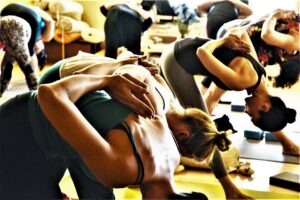
Yoga is one indoor activity that many people enjoy.
BY DEBRA KEEFER RAMAGE
Healthy eating – let food be your medicine
The phrase “Let food be thy medicine” is often attributed to Hippocrates. But a Dutch doctor specializing in nutrition and natural medicine (see www.drgoodfood.org/en/vitarecipes/foodfixes) scanned every known bit of writing by him and found nothing that can be translated directly into this. However, Hippocrates did consider “diaitímasí” (a Greek word that is the root of our word “diet” but also encompasses other lifestyle factors like exercise and sleep) to be essential to health and included it in the umbrella term “treatments” in the Hippocratic Oath. Treatments to ancient and near-modern doctors also included “farmako,” or medicine, but not to the extreme and virtually exclusive degree it does now.
I found a wealth of other good aphorisms about diet and health. One of the first hits, and now a personal favorite, was “You are what you eat, so don’t be fast, cheap, easy or fake.” The original author of this gem is unknown. Even though I like it, the only one I would fight to the death for is the last, fake. (And not even that, depending on how strictly you interpret it. Some people consider oat milk and tofu to be fake.) I think, in a busy lifestyle, there is room for fast and easy food that is still healthy, and excoriating someone for being cheap, either in their food choices or their wider life choices, is a bit too classist for me.
The problem with the “cheap” part of the mindset behind the quote is that our government subsidizes certain unhealthy and deracinated foods specifically because they are thought to be good enough for the poor, while the overproduction of them is good for Big Ag. Specifically, we can name nonorganic (glyphosate-saturated at harvest) wheat flour, corn syrup, white sugar, soybean cattle feed, and factory-farmed meat and poultry as receivers of government blessing and funding.
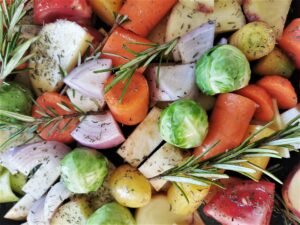
Roasting vegetables
Go-to (and seasonal!) dishes, meals and snacks
To make informed decisions about what to eat, it’s best to have a plan – but a realistic one. Every time I have tried to make a strict list in advance of what I would eat when, something always derailed it. Better to have flexible plans and guidelines, and a pantry that you can fall back on.
Dividing the year into spring-summer and fall-winter, for each season choose your three favorite fruits and your five favorite vegetables, and make sure you have at least one of each on hand at all times (preferably fresh, but including frozen for backup). Also have three fallback meals for each half of the year, something you can make on autopilot, easy and maybe even fast and cheap!
One of my fall-winter fallbacks is roasted Brussels sprouts (see the recent
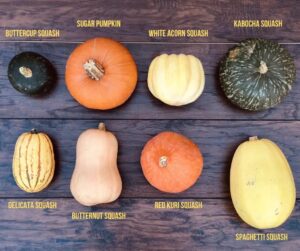
8 winter squashes
Thanksgiving article for a rough recipe). Another is roasted squash and root vegetables, with a combination of two or three from the list of roots (beets, potatoes, celeriac, turnips, parsnips, carrots, sweet potatoes) and squashes (delicata, butternut, acorn, kabocha, red kuri). These can be cut into bite-size or slightly larger pieces, seasoned creatively, and drizzled with olive oil. Roast until soft and slightly browned. If you add meat or another protein (turkey, tofu, vegetarian sausage) it is a full meal.
Meal-sized salads are also a great option for less-effort home cooking. I get a delivery of frozen wild-caught Alaskan salmon every two months, so I always have salmon in my freezer, and all year round, I often make a salad with seasonal bitter greens, chopped cold boiled potatoes, chopped hard-boiled eggs, and poached or grilled salmon cooled to room temperature and torn into bite-size chunks, finished with a tangy dressing.
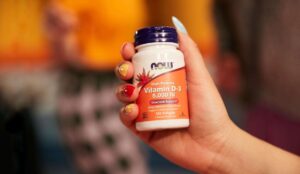
Vitamin D
Supplements – what you need and don’t need
According to WebMD (my best source for info on drugs, supplements and herbs) about half of U.S. adults take at least one supplement.
The supplements you need depend on a number of factors including:
• Your age and underlying health conditions.
• Your hormonal status, which can include gender, age, and other factors (e.g., diabetes, using hormonal birth control, etc.).
• The quality of your diet, air, and amount of sunshine you get.
• Medications you are taking regularly, if any.
Along with handy checklists, WebMD gives more detailed guidance here: www.webmd.com/pain-management/features/what-vitamin-should-i-take. Here we learn that the most frequent vitamin deficiency in generally well-fed developed nations is vitamin D. Although you can take too much vitamin D with resulting health risks, it’s safe in normal doses. Factors that contribute to vitamin D deficiency include living in higher latitudes with less sunshine in the winter or having dark skin, and especially the combination of the two. There are also lists of other factors likely to result in a vitamin deficiency, and symptoms that may point to one.
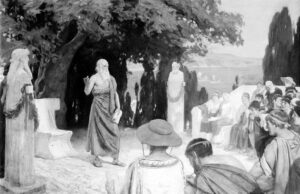
Famous Hippocrates mural from Wellcome Institute London
Your brain is part of your body, too
There is a tendency in Western philosophy and medicine to see the brain as somehow distinct from the body. But it’s a part of your body, and integral to your complete body’s health. And since your brain, after all, is what makes decisions like what to eat, it makes sense to get your brain in gear so that it doesn’t subvert your program.
Did you know that brain power is not a matter of brain size or the number of healthy brain cells? The true determinant factor is the number and complexity of neural connections between the brain cells, and these are created by learning, experience and attention. As we age, the creation of new brain cells slows down, and certain activities, like drinking alcohol or playing extreme sports, may even kill brain cells. But none of those stops the ability to build new connections among the remaining neurons, an activity called neuroplasticity, which you have right up to the moment you die, unless it’s diminished by certain illnesses.
Here is a handy list of activities that build new neural connections and contribute to brain health:
• Doing and learning new things – be a lifelong student and curious as a toddler.
• Reducing stress, including via philosophy, spirituality or psychotherapy.
• Exercise, especially if combined with learning or new experiences.
• Listening to music and dancing (both lay down new neural pathways).
• Teaching, arguing, debating, persuading, anything where you have to think on your feet.
• Art, crafts, writing, redecorating – the first three require you to use close observation, which is good for your memory, and the fourth gives you new neural connections just by changing your visual environment.
• If you have trouble with initiative, try an app: Lumosity, Cognifit, Personal Zen, or play brain games like Sudoku, Anagrams, Concentration or chess.
• It helps to get your hearing and vision checked and corrected if need be. People often stop paying attention and learning due to vision or hearing loss.
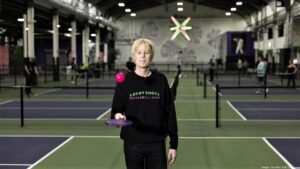
Local pickleball club
Exercise in the Minnesota winter
How to get exercise in the frigid temps of our sweet home may be a problem. If you’re fit and skilled enough for winter biking, cross-country skiing or snowshoe hikes, good for you and do that. If you’re a member of the Y and have a car to get there, you can still swim in the winter. But what if not?
One big favorite right now is pickleball. Minnesota is one of the top three in the nation for number of pickleball courts per capita, and bars and taprooms are springing up with their own courts. Another great netball option is indoor tennis. Both Minneapolis and St. Paul have great programs for both kids and adults.
Also, there is walking. Bundle up, watch your step and walk outside when you can. When or if you just can’t go outside, try mall-walking, stadium-walking or that very Minnesota version of indoor walking, hiking the skyways.























